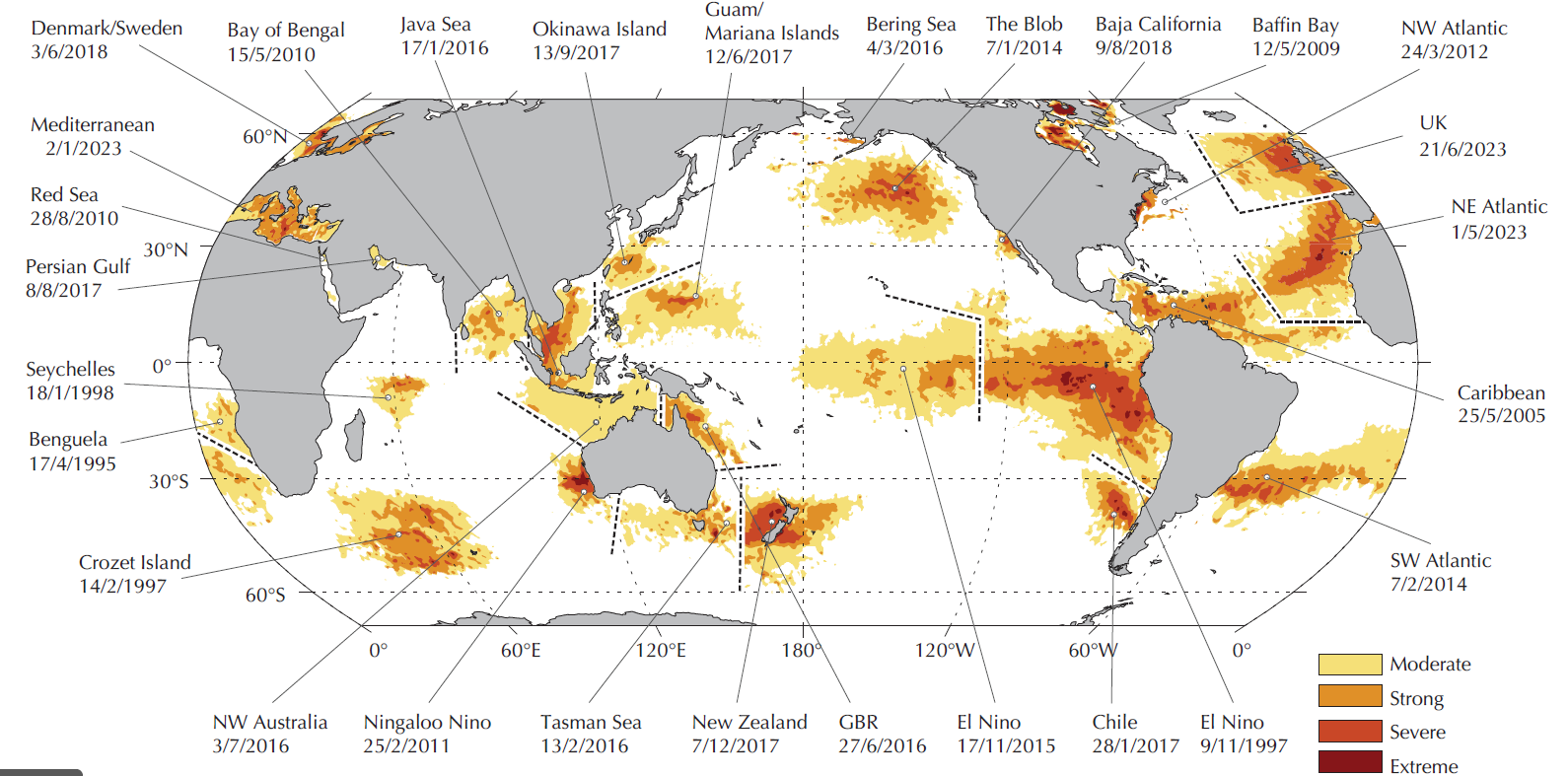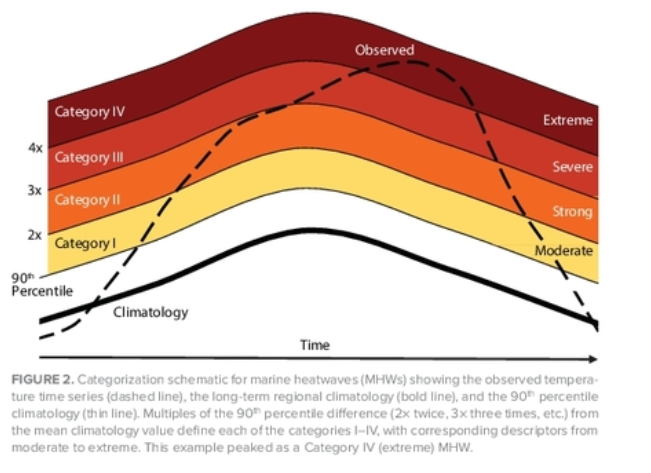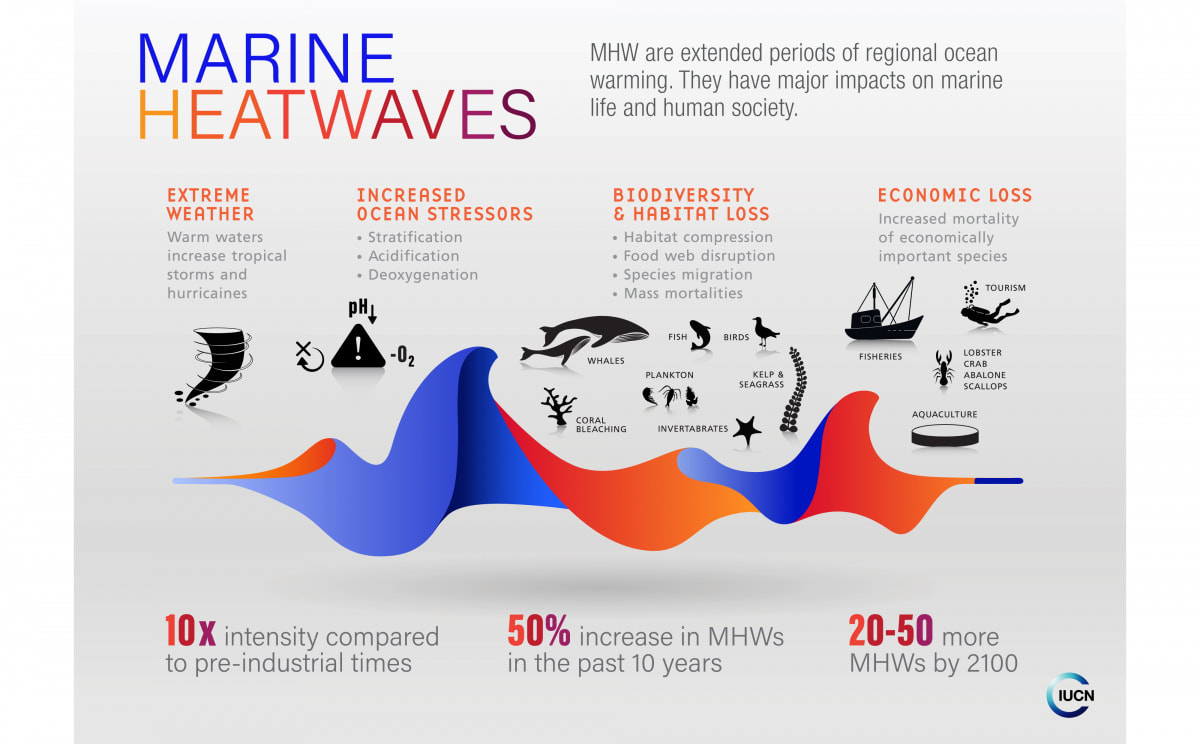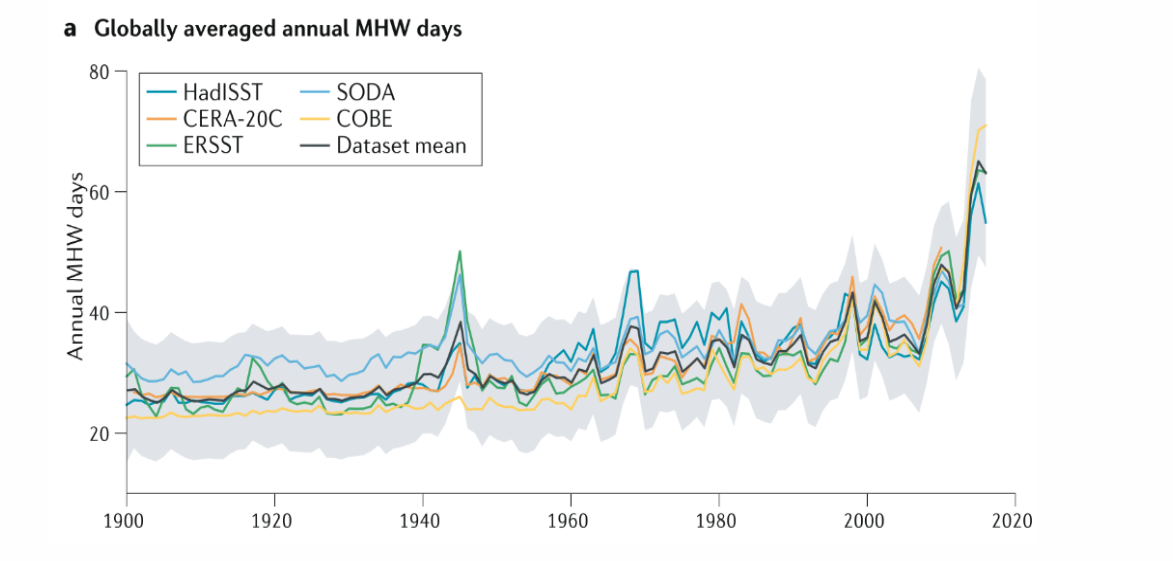what is a marine heatwave?
We know that heatwaves occur in the atmosphere. We are all familiar with these extended periods of excessively hot weather. However, periods of extreme heat also occur in the ocean and these are known as marine heatwaves, or MHWs. These extreme warming events can have significant impacts on marine ecosystems as well as human wellbeing and regional economies. MHWs can occur in any season - they are defined based on differences with expected sea temperatures for the location and time of year.
How do we measure marine heatwaves?Our group developed a definition of MHWs (Hobday et al. 2016), which has been widely adopted by researchers and other users. A MHW is defined as a period when seawater temperatures exceed a seasonally-varying threshold (usually the 90th percentile) for at least 5 consecutive days. Successive events with gaps of 2 days or less are considered part of the same MHW. In a subsequent study (Hobday et al. 2018) we extended the definition to introduce categories of severity, based on multiples of the threshold being exceeded.
|
CODE: Links to Python and R implementations of the Marine Heatwave definition of Hobday et al. (2016).
Marine heatwave properties
Once MHWs are defined, we can define each event by a set of properties including duration (time from the start to end date, in days), intensity (the temperature anomaly above the climatology, in °C, meaning how much warmer than expected for that time of year), and cumulative intensity (the integral of intensity over the duration of the event, similar to “degree heating days” or “degree heating weeks”). Over a whole year we can define the annual frequency (count of events in a particular year) and the annual marine heatwave days (the count of days in a year that were classified as being a MHW).
Summer marine heatwaves vs. winter warm spellsHeatwaves can happen at any time of year, although the most extreme absolute sea temperatures are generally observed during summertime MHWs, which can become stressful to marine life. MHWs that occur in other seasons can also have important impacts, such as in the southeast of Australia where the spiny sea urchin can only colonise further south when winter temperatures are above 12 °C.
|
What causes marine heatwaves?MHWs are caused by a wide range of processes, which vary in their importance between regions and events. The most common drivers of MHWs include ocean currents which can build up areas of warm water and air-sea heat flux, or warming through the ocean surface from the atmosphere. Winds can enhance or suppress the warming in a MHW, and climate modes like El Niño can change the likelihood of events occurring in certain regions.
|
How have marine heatwaves changed?The oceans are warming at an unprecedented rate. Global sea surface temperatures have warmed by nearly 1°C since 1900 (IPCC AR6). This warming in turn increases the likelihood of MHWs occurring. While ecosystems have evolved within a certain coping range, and can adapt to conditions slightly outside that range, MHWs manifest as extreme events that lead to ecosystem vulnerabilities. In a warmer climate we are more likely to experience these vulnerability-causing extremes.
|
what about the future?The Intergovernmental Panel on Climate Change (IPCC) 6th assessment report projects that the global ocean will continue to warm well into the 21st century. The warming in the upper ocean is projected to be between 0.5°C and 2.5°C by 2100. We can therefore expect a continuation, and possibly acceleration, of the historic warming-driven changes in MHWs. Ultimately, without improved global action to tackle climate change, the oceans will continue to warm leading to more intense and frequent MHWs, with consequences for marine life and human societies.
|
Further reading
Hobday et al. (2016), A hierarchical approach to defining marine heatwaves, Progress in Oceanography, 141, pp. 227-238, 10.1016/j.pocean.2015.12.014
Hobday et al. (2018), Categorizing and naming marine heatwaves, Oceanography, 31, pp. 162-173, https://www.jstor.org/stable/26542662
Smale et al (2019), Marine heatwaves threaten global biodiversity and the provision of ecosystem services, Nature Climate Change, 9, 306–312
Smith et al. (2021) Socioeconomic impacts of marine heatwaves: Global issues and opportunities, Science 374: 6566
Wernberg et al. (2013), An extreme climatic event alters marine ecosystem structure in a global biodiversity hotspot. Nature Climate Change 3, pages78–82
Hobday et al. (2016), A hierarchical approach to defining marine heatwaves, Progress in Oceanography, 141, pp. 227-238, 10.1016/j.pocean.2015.12.014
Hobday et al. (2018), Categorizing and naming marine heatwaves, Oceanography, 31, pp. 162-173, https://www.jstor.org/stable/26542662
Smale et al (2019), Marine heatwaves threaten global biodiversity and the provision of ecosystem services, Nature Climate Change, 9, 306–312
Smith et al. (2021) Socioeconomic impacts of marine heatwaves: Global issues and opportunities, Science 374: 6566
Wernberg et al. (2013), An extreme climatic event alters marine ecosystem structure in a global biodiversity hotspot. Nature Climate Change 3, pages78–82



